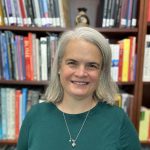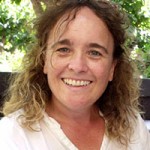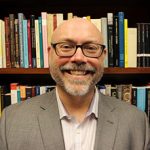About
Faculty Updates 2021
Despite interruptions from COVID-19, Classical Studies faculty have continued to produce robust scholarship over the past year. Highlights include the publication of textbooks, invited talks across the nation, and research into disasters in the ancient world.
Read updates from each of our faculty members here:
 Susan Shelmerdine published Introduction to Greek co-authored with her sister in 2020 and is currently working on the 3rd edition of her Introduction to Latin textbook. She continues to be interested in ancient language pedagogy and for the March 2022 meeting of the Classical Association of the Middle West and South is a co-presenter/organizer for a workshop on reading Latin & Greek and the organizer of a roundtable on planning for accessible teaching methods courses. Her Golden Retrievers, Kylie and Sophie, are now 10 and 10 ½ (!) and love doing therapy visits as well as nose work classes and trials.
Susan Shelmerdine published Introduction to Greek co-authored with her sister in 2020 and is currently working on the 3rd edition of her Introduction to Latin textbook. She continues to be interested in ancient language pedagogy and for the March 2022 meeting of the Classical Association of the Middle West and South is a co-presenter/organizer for a workshop on reading Latin & Greek and the organizer of a roundtable on planning for accessible teaching methods courses. Her Golden Retrievers, Kylie and Sophie, are now 10 and 10 ½ (!) and love doing therapy visits as well as nose work classes and trials.
 Robyn Le Blanc has been hard at work on articles and chapters related to her current project on Roman colonial coinages. This project explores how typically “Roman” symbols such as Aeneas, Romulus and Remus, and depictions of city foundation rituals appear on coins minted by provincial cities, and what messages they expressed about being part of the Roman empire. She has also been actively sharing her research through invited talks at the University of Illinois at Urbana-Champaign, the University of Pittsburgh, and the University of Kansas, and was named a 2021–22 Kershaw Lecturer in Near East Archaeology for the Archaeological Institute of America. Dr. Le Blanc has been teaching her usual rotation of classes this year, some with a new twist–in the Age of Constantine, students designed video games or tv shows based on Late Antiquity, and in Age of Alexander, students created an online audio-guided tour of Hellenistic coins. After school, she has been chasing after her now-18-month old, who loves reading and dropping things on the ground and exclaiming “uh-oh!”
Robyn Le Blanc has been hard at work on articles and chapters related to her current project on Roman colonial coinages. This project explores how typically “Roman” symbols such as Aeneas, Romulus and Remus, and depictions of city foundation rituals appear on coins minted by provincial cities, and what messages they expressed about being part of the Roman empire. She has also been actively sharing her research through invited talks at the University of Illinois at Urbana-Champaign, the University of Pittsburgh, and the University of Kansas, and was named a 2021–22 Kershaw Lecturer in Near East Archaeology for the Archaeological Institute of America. Dr. Le Blanc has been teaching her usual rotation of classes this year, some with a new twist–in the Age of Constantine, students designed video games or tv shows based on Late Antiquity, and in Age of Alexander, students created an online audio-guided tour of Hellenistic coins. After school, she has been chasing after her now-18-month old, who loves reading and dropping things on the ground and exclaiming “uh-oh!”
 Michiel van Veldhuizen: Another year defined by the pandemic, which, for all its general awfulness, continues to provide food for thought as far as his research is concerned. Michiel works on disasters in the ancient world, and was invited to give a lecture on this topic for the Society for Ancient Mediterranean Religions. He discussed plague discourse in Herodotus, Thucydides, and Josephus, and in particular the idea that plague is something kreisson logou (‘greater than reason’, or ‘beyond comprehension’). It is fascinating to see how our COVID-19 discourse partakes of similar strategies of meaning-making. Teaching Classical Mythology has been a joy, especially when one student was apparently so taken by the discussion of herms that he crocheted him one, phallus and all. His Ancient Greek students have been dedicated as always, wrestling with Medea’s decision to murder her own children in Euripides’ tragic play, or deciphering the puzzling oracles in Herodotus’ Histories. He is currently planning a research trip to Turkey’s Aegean coast this summer, to visit some oracular sites that — as inscriptions tell us — successfully warded off multiple plagues in antiquity… Maybe there’s something there for us as we can hopefully close this pandemic chapter soon.
Michiel van Veldhuizen: Another year defined by the pandemic, which, for all its general awfulness, continues to provide food for thought as far as his research is concerned. Michiel works on disasters in the ancient world, and was invited to give a lecture on this topic for the Society for Ancient Mediterranean Religions. He discussed plague discourse in Herodotus, Thucydides, and Josephus, and in particular the idea that plague is something kreisson logou (‘greater than reason’, or ‘beyond comprehension’). It is fascinating to see how our COVID-19 discourse partakes of similar strategies of meaning-making. Teaching Classical Mythology has been a joy, especially when one student was apparently so taken by the discussion of herms that he crocheted him one, phallus and all. His Ancient Greek students have been dedicated as always, wrestling with Medea’s decision to murder her own children in Euripides’ tragic play, or deciphering the puzzling oracles in Herodotus’ Histories. He is currently planning a research trip to Turkey’s Aegean coast this summer, to visit some oracular sites that — as inscriptions tell us — successfully warded off multiple plagues in antiquity… Maybe there’s something there for us as we can hopefully close this pandemic chapter soon.
 Maura Heyn started the year chairing a session on unusual elements in Palmyrene iconography at the annual meeting of the Archaeological Institute of America (from her sun porch in Greensboro, naturally). She and her co-chair are currently editing the papers for publication as an edited volume with Brepols. She also participated in the Bridges program, which is a professional development program run from the The Friday Center at UNC Chapel Hill and is dedicated to supporting women in higher education. She loved seeing all the UNCG in Rome alumni at Oden Brewing Company in October and is looking forward to strolling the streets of Rome with UNCG students in May 2022.
Maura Heyn started the year chairing a session on unusual elements in Palmyrene iconography at the annual meeting of the Archaeological Institute of America (from her sun porch in Greensboro, naturally). She and her co-chair are currently editing the papers for publication as an edited volume with Brepols. She also participated in the Bridges program, which is a professional development program run from the The Friday Center at UNC Chapel Hill and is dedicated to supporting women in higher education. She loved seeing all the UNCG in Rome alumni at Oden Brewing Company in October and is looking forward to strolling the streets of Rome with UNCG students in May 2022.
 David Wharton‘s edited volume A Cultural History of Color in Antiquity, for which he wrote the introduction and co-authored two chapters, was published by Bloomsbury Academic in 2021. A follow-up book proposal, Understanding Latin’s Language of Color, is currently under review at Oxford University Press. On the teaching front, he developed and taught a new freshman Foundations course, The Spartans, and created a capstone seminar on Color in Antiquity. He will be on research leave in Fall 2022.
David Wharton‘s edited volume A Cultural History of Color in Antiquity, for which he wrote the introduction and co-authored two chapters, was published by Bloomsbury Academic in 2021. A follow-up book proposal, Understanding Latin’s Language of Color, is currently under review at Oxford University Press. On the teaching front, he developed and taught a new freshman Foundations course, The Spartans, and created a capstone seminar on Color in Antiquity. He will be on research leave in Fall 2022.
 Joanne Murphy continues to work on Bronze Age ritual and her survey on the Cycladic island of Kea, Greece. Her book on tombs around the Bronze Age Palace at Pylos was accepted during the year for publication by INSTAP Academic Press and is currently in press. Although she and her team on the Kea Archaeological Research Survey (KARS) project have been plugging away at several papers on the results of the project, they were unable to conduct a field season in 2021. This year, however, we are determined to return to Kea. In October she led a tour of Crete and the Island for the Archaeological Institute of America, which was a lot of fun. Several of the participants are going to join her for 10 days in Greece at the start of the KARS project this summer – reach out to her if you would like to join us some summer. Most recently she accepted a new role as the Director of the Irish Institute of Hellenic Studies at Athens – thankfully most of the directing will be done from Greensboro.
Joanne Murphy continues to work on Bronze Age ritual and her survey on the Cycladic island of Kea, Greece. Her book on tombs around the Bronze Age Palace at Pylos was accepted during the year for publication by INSTAP Academic Press and is currently in press. Although she and her team on the Kea Archaeological Research Survey (KARS) project have been plugging away at several papers on the results of the project, they were unable to conduct a field season in 2021. This year, however, we are determined to return to Kea. In October she led a tour of Crete and the Island for the Archaeological Institute of America, which was a lot of fun. Several of the participants are going to join her for 10 days in Greece at the start of the KARS project this summer – reach out to her if you would like to join us some summer. Most recently she accepted a new role as the Director of the Irish Institute of Hellenic Studies at Athens – thankfully most of the directing will be done from Greensboro.
 Jonathan Zarecki has been plugging along on a couple projects related to Cicero, on the concept of political legitimacy (part of which he delivered at the annual meeting of CAMWS) and on the politics of old age in the Philippics, and a new project on performative bullsh*t in Cicero’s speeches. He created new courses on public opinion in the Roman Empire and science fiction as a way to understand ancient thought and culture. He was also invited to join the steering committee for the Leadership Development for Everyone through the Humanities initiative with the Kallion organization and is very much looking forward to that committee’s work.
Jonathan Zarecki has been plugging along on a couple projects related to Cicero, on the concept of political legitimacy (part of which he delivered at the annual meeting of CAMWS) and on the politics of old age in the Philippics, and a new project on performative bullsh*t in Cicero’s speeches. He created new courses on public opinion in the Roman Empire and science fiction as a way to understand ancient thought and culture. He was also invited to join the steering committee for the Leadership Development for Everyone through the Humanities initiative with the Kallion organization and is very much looking forward to that committee’s work.





